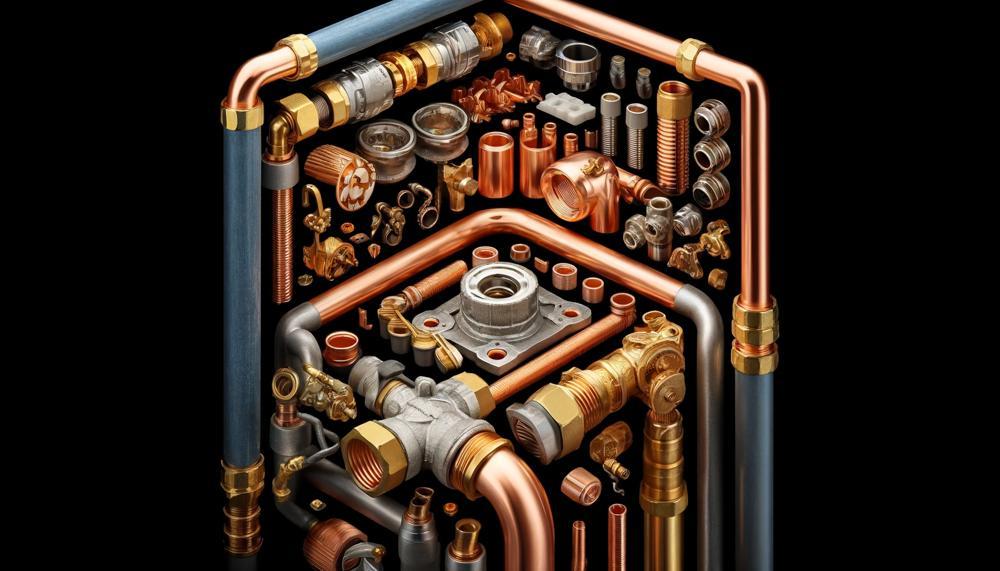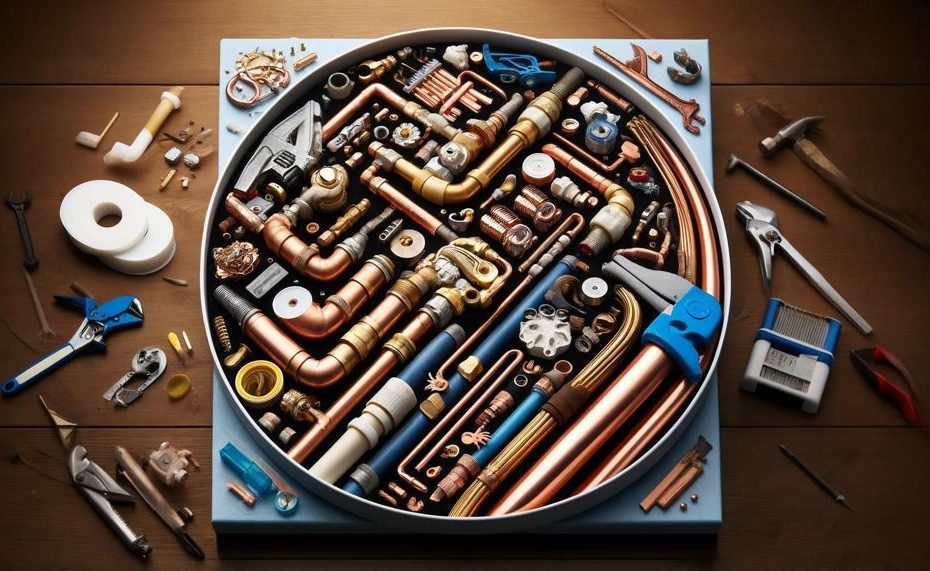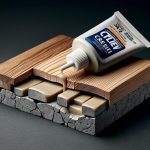Actually, almost 60% of all new plumbing installations in homes now use PEX tubes. This bendable, strong material has changed the way we think about plumbing. Compared to standard copper lines, it is easier to install and lasts a lot longer. A common question that comes up is: Can you connect PEX to copper? This is because many homeowners and do-it-yourselfers want to fix or upgrade their water systems.
PEX is appealing because it is simple, but switching to copper often needs a bit more care.
PEX tubing and copper pipes are fundamentally different in their structure and material properties, which influences how they can be joined.
So, can i glue pex to copper?
No, you cannot directly glue PEX to copper. However, you can connect PEX to copper using specific fittings and methods. Here are a few options:
- Sweat Adapters: These adapters create a solid connection between copper and PEX supply lines1. They are soldered—or “sweated”—onto the copper tubing, allowing for a solid connection between the copper and the PEX.
- Threaded Fittings: These come in two parts, often sold separately. Half attaches to the PEX pipe, and the other half attaches to the existing copper pipe.
- SharkBite Fittings: SharkBite Universal brass push-to-connect fittings can be used on PEX as well as copper.
Remember, each method requires specific tools and steps, so make sure you have the right equipment and understand the process before you start. If you’re unsure, it might be best to hire a professional plumber.
Please note that while adhesives like epoxy resins can be used to glue copper, they are not suitable for connecting PEX to copper. PEX and copper have different thermal expansion rates, which can lead to a failure of the joint over time if glued together.
Understanding these key points will guide homeowners and professionals alike in successfully integrating PEX with existing copper plumbing, combining the best of both worlds in modern plumbing practices.

Table of Contents
- 1 What Are PEX and Copper?
- 2 Why Glue is Not Used for Joining PEX and Copper Pipes
- 3 Alternatives to Gluing for Connecting PEX and Copper Pipes
- 4 Crimping Method for Connecting PEX Pipes
- 5 Cinching/Clamp/Ring Method for Connecting PEX Pipes
- 6 Soldering Method for Connecting Copper Pipes
- 7 Compression Fitting Method for Connecting Copper Pipes
- 8 Transition Fittings for Joining Different Materials
- 9 Conclusion
What Are PEX and Copper?
PEX (cross-linked polyethylene) and copper are both materials commonly used for water supply piping systems in buildings. Each material exhibits unique properties and suits different plumbing needs and environments.
PEX is known for its flexibility, resistance to freeze-breakage, and ease of installation. This plastic tubing is quickly becoming favored in residential plumbing for both new construction and retrofitting projects due to its cost-effectiveness and minimal maintenance requirements.
Copper, on the other hand, has been a traditional choice for plumbing for many decades. It is known for its durability and the natural antibacterial properties it possesses. However, copper pipes are more susceptible to corrosion and can be damaged by freezing temperatures, which can cause the pipes to burst.
Table Summarizing Differences and Gluing Process:
| Aspect | PEX | Copper |
|---|---|---|
| Flexibility | Highly flexible, can be snaked through walls and structures without multiple joints. | Relatively rigid, requires more joints and fittings for installation. |
| Freeze Resistance | High resistance to freezing; less likely to burst if frozen. | Low resistance; prone to bursting under freeze conditions. |
| Installation | Does not require soldering; uses mechanical fittings, often easier and safer to install. | Typically requires soldering, needing a torch and creating potential hazards in confined spaces. |
| Cost | Generally cheaper and requires less labor. | More expensive, both in terms of material costs and labor. |
| Suitability | Ideal for both new constructions and retrofitting projects. | Preferred in new constructions and where higher durability is required. |
Discussion of Gluing Process:
The differences between PEX and copper significantly influence the methods used for connecting these pipes. Copper requires a process called soldering, which involves heating the pipes to melt solder that forms a seal. This method requires skill and appropriate safety measures due to the use of open flames and lead-based solder materials.
PEX, by contrast, does not typically utilize “gluing” in the traditional sense used with PVC or copper. Instead, PEX connections are made using specialized fittings such as barbed fittings with crimp rings or push-fit connectors that seal the connection without the need for heat or solder. This makes PEX more user-friendly and less hazardous to install, particularly for DIY projects.
Why Glue is Not Used for Joining PEX and Copper Pipes
Glue is not recommended for joining PEX and copper pipes primarily due to the distinct characteristics and thermal behavior of each material. Here’s a detailed explanation of why alternative methods are favored over adhesives:
- Material Incompatibility: PEX (cross-linked polyethylene) and copper differ fundamentally in composition and properties. PEX is a flexible, plastic-like material, while copper is a rigid, metallic substance. Glues typically used in plumbing are designed for similar material types, making them ineffective at creating a durable bond between such dissimilar materials.
- Thermal Expansion and Contraction: Copper and PEX expand and contract at different rates due to temperature changes. This discrepancy can cause the bond formed by glue to weaken over time, leading to leaks and structural failures in the piping system.
- Longevity and Reliability: Plumbing requires robust, leak-proof connections that can withstand years of dynamic pressures and temperature fluctuations. Methods like soldering for copper and specialized fittings for PEX are engineered to meet these demands, providing connections that are more durable and reliable than what can be achieved with glue.
- Ease of Installation and Safety: Using glue can be messy and requires precise application. The alternatives, such as compression fittings, push-to-connect fittings, and transition fittings, offer cleaner, faster, and often tool-free installations. These methods also reduce the risk of errors and potential hazards associated with improper use of adhesives.
Alternatives to Gluing for Connecting PEX and Copper Pipes
Alternatives to using glue for connecting PEX and copper pipes include several more reliable and effective methods, each tailored to different installation needs and plumbing configurations.
Below is a detailed look at these alternatives, presented in a clear table format for ease of understanding and comparison.
| Method | Description | Usage |
| Crimp Rings | Metal rings that are placed over the PEX pipe and fitting, then compressed with a special tool to secure the connection. | Ideal for tight spaces where a solid, leak-proof connection is required. |
| Cinch Rings | Similar to crimp rings but use a cinching tool to ensure a tight seal. | Used in residential water systems for securing PEX piping. |
| Push-to-Connect Fittings | Fittings with a built-in mechanism that locks the pipe in place when pushed into the fitting. | Suitable for quick repairs and easy installations, allowing for immediate water flow. |
| Compression Fittings | Utilize a compression nut and ring to form a watertight seal when tightened onto the PEX pipe. | Great for situations where a temporary or adjustable connection is beneficial. |
| SharkBite Fittings | Innovative fittings that connect to copper pipes without the need for any special tools. | Perfect for transitional connections between PEX and copper in both repairs and new installs. |
These methods provide a dependable alternative to gluing, ensuring a secure, robust joint between PEX and copper pipes.
The choice of method depends largely on the specific requirements of the plumbing system, the tools available, and the plumber’s preference for ease of installation versus long-term reliability.
Crimping Method for Connecting PEX Pipes
To effectively connect PEX pipes using the crimping method, specific materials and tools are essential. Below is a detailed breakdown of each component necessary for a successful installation:
| Material/Tool | Description | Use |
| PEX Tubing | Flexible plastic piping | Transports water within the system |
| Crimp Fittings | Metal fittings, typically made of brass or copper | Connects sections of PEX tubing |
| Crimp Rings | Metal rings, usually copper or stainless steel | Secures the crimp fittings to the tubing |
| Crimp Tool | Specialized plier-like tool | Compresses the crimp rings to seal the connection |
| Go/no-go Gauge | Measurement tool | Ensures crimp rings are adequately tightened |
| De-crimping Tool | Tool for cutting crimp rings | Removes fittings in case of errors |
These components work in unison to ensure a leak-proof and durable connection. The crimp tool is used to tighten the crimp rings around the fittings and tubing, while the go/no-go gauge verifies the tightness to avoid any under or over-crimping.
For corrections or adjustments, the de-crimping tool (or a regular knife in its absence) is handy for safely removing a crimp ring without damaging the tubing.
Given the different designs of fittings and rings specific to the crimping method, it’s crucial to select compatible components to prevent any installation issues.
This setup not only provides a secure connection but also offers longevity and reliability for plumbing systems, particularly in household applications.
Cinching/Clamp/Ring Method for Connecting PEX Pipes
Answer: The cinching or clamp method, often referred to as the ring method, is a reliable technique for joining PEX pipes to copper pipes. This method utilizes a metal cinch clamp or crimp ring to secure the connection, ensuring both durability and tight sealing.
Here’s a step-by-step breakdown of how it’s done:
- Preparation: Slide the cinch clamp or crimp ring over the end of the PEX pipe.
- Insertion: Fit the end of the PEX pipe onto the copper pipe fitting. Ensure it’s snug and pushed all the way on.
- Securing: Position the cinch clamp or crimp ring around the joint where the PEX meets the copper pipe. Use a specialized cinching or crimping tool to tighten the clamp or ring around the PEX, compressing it against the copper to create a watertight seal.
The effectiveness of this method lies in its simplicity and cost-effectiveness. While other methods, like push-fit fittings, offer convenience without tools, they come at a higher price. In contrast, the cinching method provides a balance of affordability and reliability without requiring sophisticated tools.
Below is a table comparing the tools and costs associated with this method versus others:
| Method | Tools Required | Cost Efficiency |
| Cinch/Clamp/Ring | Crimping tool or cinch tool | More cost-effective |
| Push-Fit | No special tools needed | Higher cost |
This method is particularly favored in scenarios where budget constraints are tight and a sturdy, long-term solution is needed.
Soldering Method for Connecting Copper Pipes
Soldering is the most effective and recommended method for connecting copper pipes, primarily due to its ability to create a durable and watertight seal that withstands high temperatures and pressures.
Unlike gluing, which can degrade over time, or crimping, which is better suited for smaller diameters, soldering uses heat and a filler material (solder) to fuse the pipe joints together permanently.
This process not only ensures a strong bond but also maintains the integrity of the pipe’s material, preventing leaks and corrosion.
| Method | Advantages | Limitations |
| Soldering | Permanent bond, suitable for all diameters, resistant to high pressure and temperature. | Requires heat application, skill needed for proper execution. |
| Crimping | Quick, no heat required, good for small diameters and quick repairs. | Not as durable as soldering, requires special tools. |
| Gluing | Simple to apply, no special tools required. | Can degrade over time, not suitable for high-pressure connections. |
Soldering stands out as it provides a robust connection essential in plumbing, where failure can lead to significant damage and repair costs. It’s particularly valuable in settings where the pipes may be hard to reach post-installation.
Ensuring a solid, leak-free join means that once in place, the soldered joints require little to no maintenance.
Compression Fitting Method for Connecting Copper Pipes
Compression fittings are a favoured choice for connecting copper pipes, particularly in settings where welding or soldering isn’t viable.
These fittings leverage mechanical force via a ferrule (a type of ring or cap), which is compressed between the nut and the fitting’s body, ensuring a watertight seal around the pipe without the need for heat.
How It Works:
- Preparation: The copper pipe is cut cleanly and deburred to avoid any damage to the ferrule.
- Fitting: The nut and ferrule are placed onto the pipe.
- Sealing: As the nut is tightened onto the fitting’s body, the ferrule is compressed onto the pipe, creating a secure seal that can handle moderate pressure and temperature variations.
This method is not only quick and efficient but also highly reliable, making it ideal for DIY projects and professional installations alike.
Can Compression Fittings Connect Copper and PEX Pipes?
Yes, compression fittings can indeed join PEX and copper pipes together. This versatility is particularly useful in mixed-material plumbing systems, allowing for flexibility in repairs and upgrades.
However, ensuring the fitting is compatible with both materials is crucial for maintaining the integrity of the connection.
| Material | Compatibility | Usage |
| Copper | Fully compatible with brass fittings | Used in plumbing, gas, and HVAC systems |
| PEX | Select fittings suitable for plastic and metal compatibility | Primarily used in plumbing applications |
Transition Fittings for Joining Different Materials
To join PEX and copper pipes, various types of transition fittings can be employed, ensuring a robust and reliable connection.
These fittings are designed to accommodate the different properties of each material, providing a secure seal and ease of installation. Here’s an overview of the primary options available:
| Type | Description | Usage Tips |
| Push-to-Connect Fittings | SharkBite and similar brands offer fittings that allow for quick, tool-free installation. They have a versatile design compatible with both PEX and copper. | Ensure the pipe ends are clean and burr-free. Simply push the pipe into the fitting until it locks in place. |
| Compression Fittings | These use a nut and ferrule to compress onto the pipes, creating a watertight seal suitable for both PEX and copper. | Align and tighten the nut properly to avoid leaks. No special tools are needed, but ensure a snug fit. |
| PEX to Copper Adapters | Specifically designed to transition from PEX tubing to copper, these adapters are ideal for mixed-material plumbing systems. | Usually requires crimping tools for PEX side and soldering or compression for the copper side. |
| Solder Adapters | Used for a permanent connection, these require soldering to attach the copper side, while the PEX end can be connected with a crimp or clamp ring. | Requires soldering skills; ensure proper safety precautions are taken during installation. |
Each of these fittings serves as a practical solution for transitioning between PEX and copper pipes, catering to different installation scenarios and requirements.
Conclusion
Integrating PEX with copper pipes is becoming a major theme in the ever-changing world of modern plumbing, especially since polyethylene ethylene is becoming more popular in home installs. But it’s not possible to glue these two things together directly. The difference between them lies in their different makeup. Copper is hard and solid, while PEX is bendable and plastic-like. Standard glue can’t attach these different substances together in a way that lasts because of their underlying differences.
Threaded sweat connections, compression fittings, and push-to-connect options make it possible for these worlds to meet. These parts handle the unique qualities of each material, eliminating the need for heat to establish a connection.
This strategy method not only makes the installation process easier, but it also greatly reduces the risks that come with traditional soldering, such as the chance of fire and the health effects that could come from breathing in solder fumes. With these different methods, both professionals and do-it-yourselfers can build a water system that lasts and works well, making the most of both PEX and copper’s best features.






